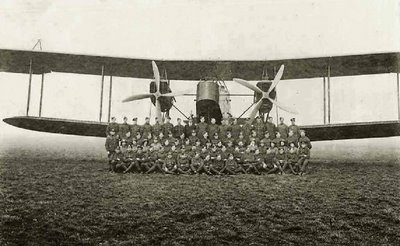Lucraft and Westcott
I had an enquiry last year from Robert Gardner who is writing a book about the companies who made aircraft propellers in World War 1. He runs a company that find and sells old aircraft parts for collectors; they cost a lot, and are mainly propellers and clocks and compasses, including the old RAF station clocks.
This picture shows a Handley-Page 0/400 bomber with the four-bladed propellers. The picture was provided to the edinphoto.org.uk website, by Ian Hawkins of Leicester, whose grandfather is “dead centre” in the picture, which was taken about 1918, probably at Hendon.
He had found that one of the companies listed was Lucraft and Westcott, about which we have reported before. It was the company originally founded by George Seeley Lucraft, son of Benjamin Lucraft, and in later years Westcott had become one of the directors and owners.
The company is listed in War ministry procurement records as having supplied propellers for the Handley Page 0/400, one of the largest long-range bombers of the first World War. The four-bladed propellers were numbered AD 575, and were fitted to the Rolls Royce 5 and 6 engines supplied for the Handley Page.
Robert was enquiring because he had seen from the Lucraft website that Nicholas Lucraft had married Margaret Westcott in 1691, and wondered if the connection between the Lucrafts and Westcotts went back all that way. (I suspect that would have given the company the world record for two families collaborating in business!) I had to tell him that there was no evidence of anything other than a coincidence, though it is not impossible that the two families knew each other in Devon and members later knew each other in London.
The company became known as one of the leading art furnishers of the turn of the century, making furniture for the major stores and for the trade. Copies of their designs were published in the trade press and Benjamin himself was introduced to Queen Victoria with one of his chairs at the London Exhibition.
By the turn of the century the company was in the hands of George Seeley Lucraft’s son, George Edmonds Lucraft who then went into business with Frederick William Westcott, who was a furniture designer like George Edmonds. In 1911 G E Lucraft and Westcott, Furniture Designers and Manufacturers who were carrying on their business at 101 Worship Street, sold their business to a new company named Lucraft and Westcott, who set up business at 17 Rushden Street, where they remained through the first World War, moving to Albert Works, Albert Road, Wood Green, between 1917 and 1919.
In 1915 the company minute book of Lucraft and Westcott showed that they had approached the company’s bank, the Capital and Counties Bank, for a loan of £350 as an overdraft in order to “carry out the War Office’s contract for 100 air screws.” All that skill in chair carving would be valuable in carving of the complex counter-curves of the four-bladed propellers for the Handley-Page’s Rolls Royce engines.
A survivor of those days, Jack E Lucraft, a young boy in the family then, can remember going to the factory in Bounds Green, and seeing the propellers being made. He believes that somewhere in the family there is a model of one of them, and says he will ask around about it.


0 Comments:
Post a Comment
<< Home